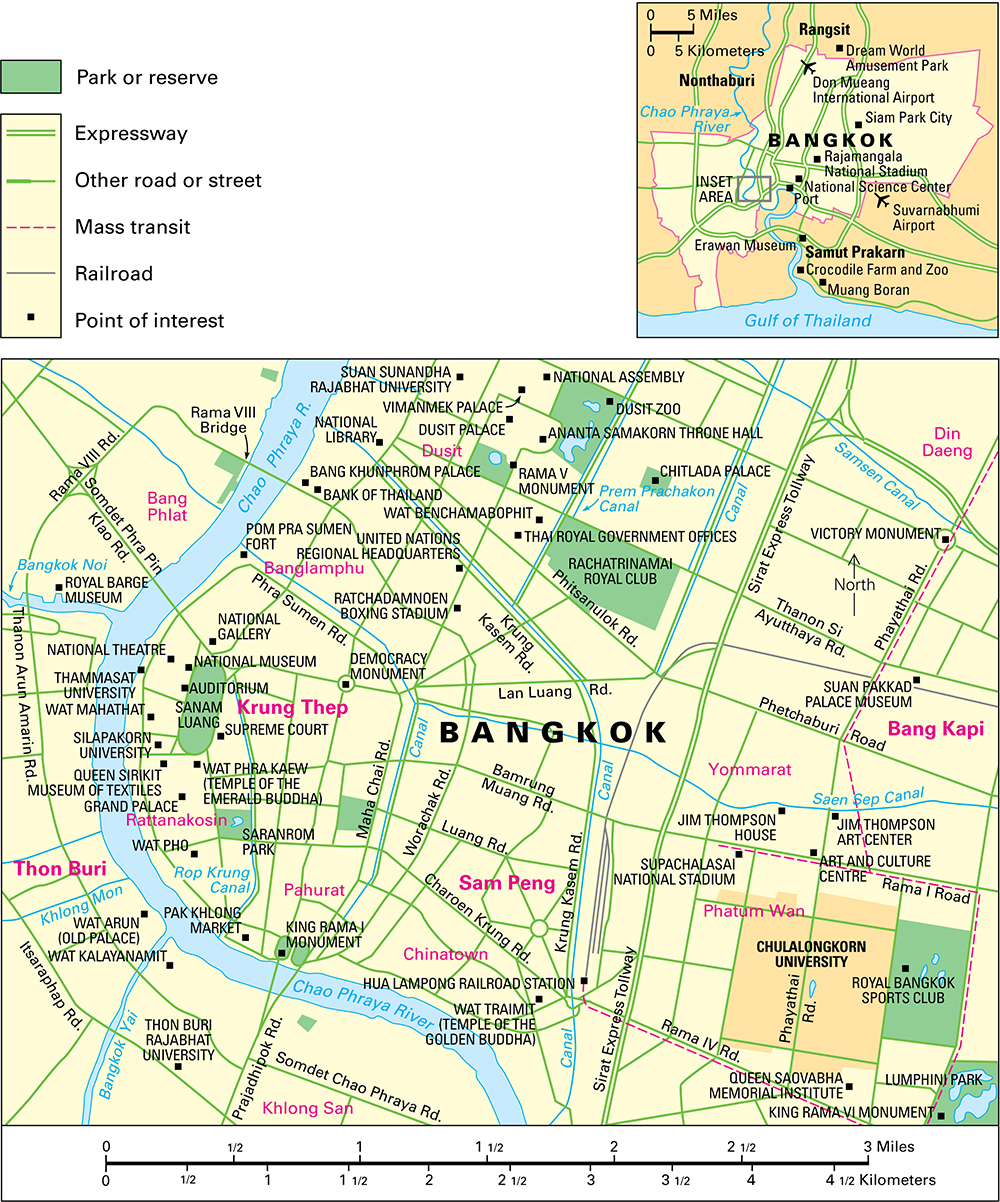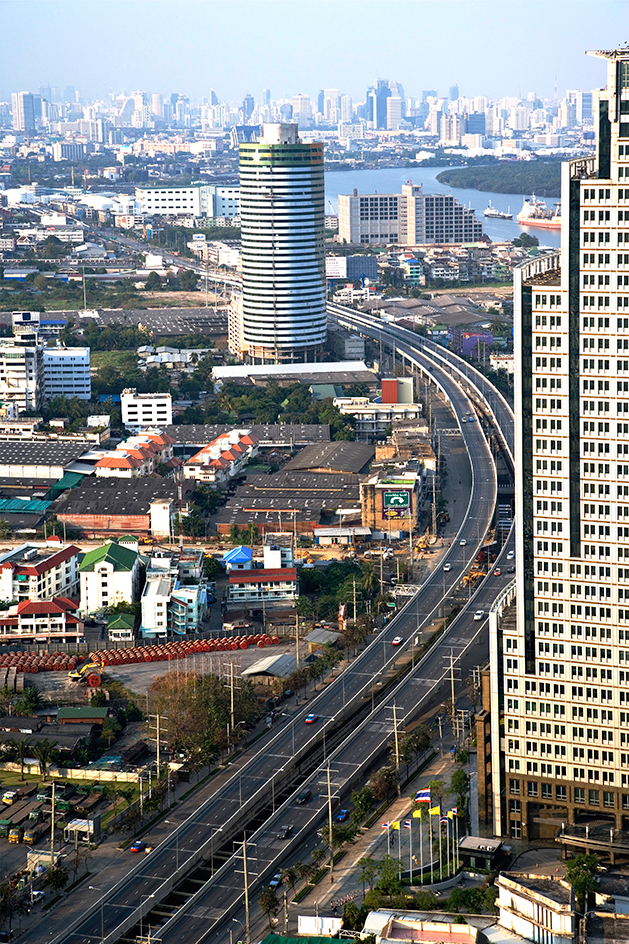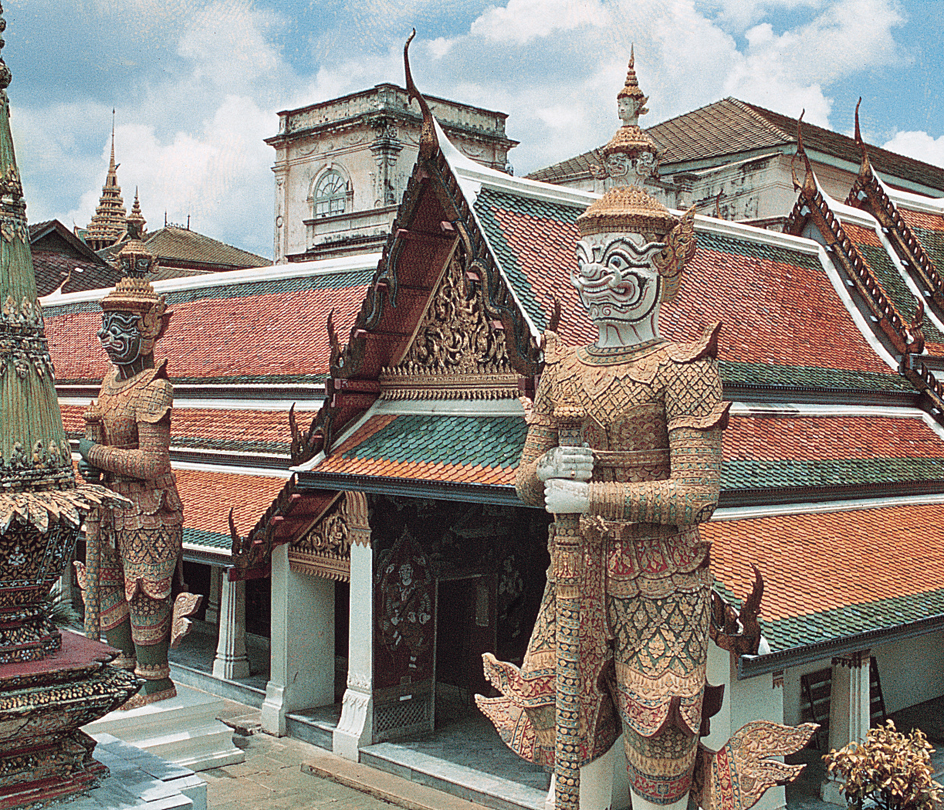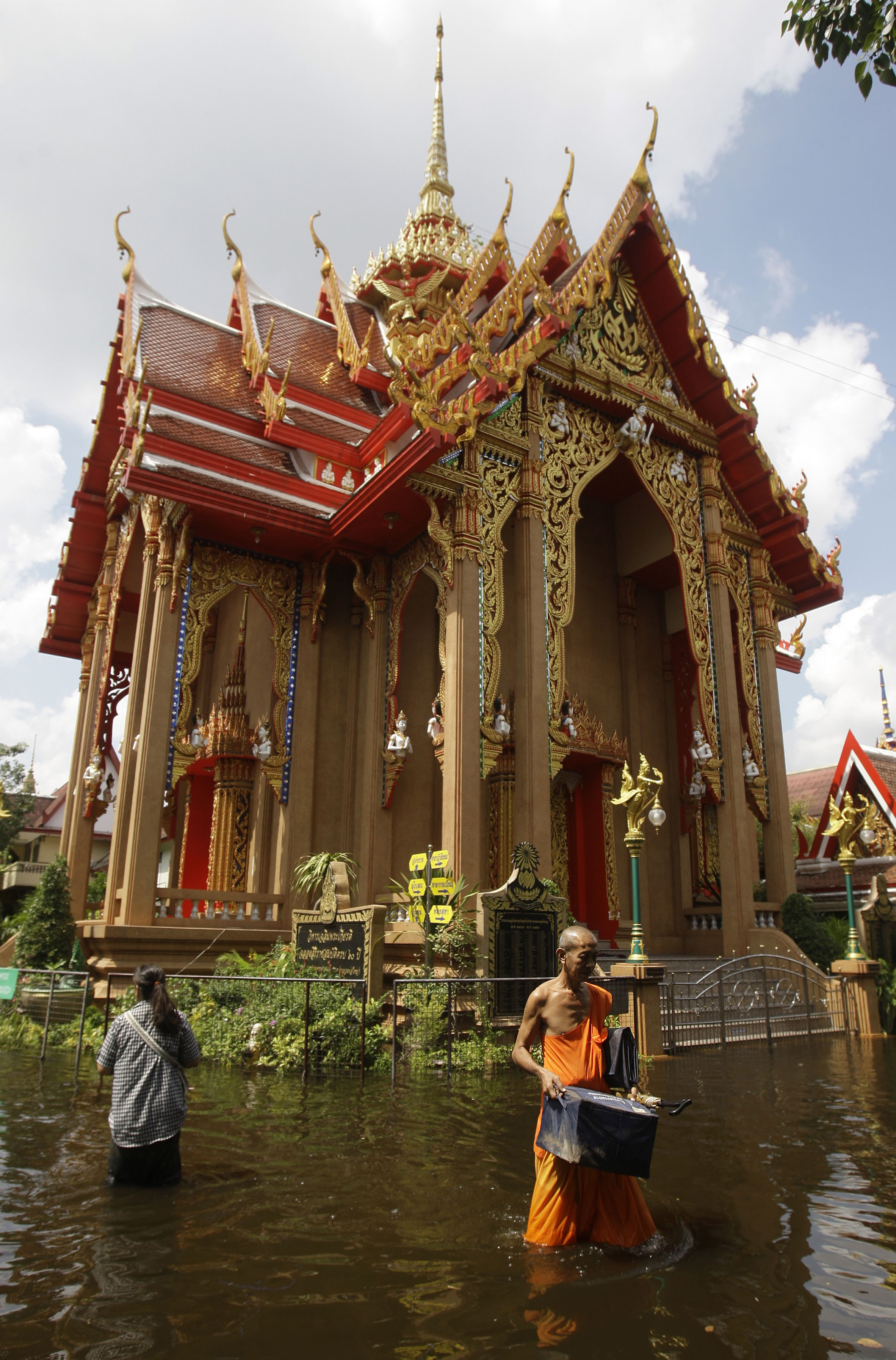Bangkok << BANG kok >> (pop. 8,305,218) is the capital and largest city of Thailand. It is the nation’s primary commercial, cultural, and industrial center. The largest part of Bangkok lies on the east bank of the Chao Phraya River. The city stands about 17 miles (27 kilometers) north of the Gulf of Thailand. Bangkok also includes an area on the west bank. The western section was formerly a separate city called Thon Buri. The Thai name for Bangkok is Krung Thep. The name means City of Angels or Heavenly City.

The city
is a sprawling, fast-growing metropolis. Many magnificent temples and palaces stand near the river. The original Grand Palace, once the home of Thai kings, overlooks the river. The palace is now used only on formal occasions. Today, the royal family lives in the Chitlada Palace, about 1 1/4 miles (2 kilometers) to the northeast.
Bangkok has a number of distinctive districts, each with its individual character. The older part of Krung Thep lies to the west, between the river front and a north-south line running through the railroad station. Newer residential and industrial areas have developed east of the station. About 3 miles (5 kilometers) east of the Grand Palace, modern hotel and office buildings line the streets. The area also has fine shops, nightclubs, and cinemas. The national Assembly Hall is surrounded by military camps.
The main commercial district is in Sam Peng, the Chinatown area. In this crowded region, the population reaches a density of 38,850 people per square mile (15,000 per square kilometer). Pahurat, the Indian quarter, is nearby. This section is noted for its textile shops. The wealthier families live at Bang Kapi, on the eastern fringe of the city. To the south of this prosperous region is a crowded, run-down area. There, poor slum-dwellers and migrants live in shacks around Khlong Toei, the port area overlooking the Gulf of Thailand.

People.
About 97 percent of Bangkok’s inhabitants are Thais. They run the government. Chinese make up the largest minority of the population. The Chinese traditionally own the city’s businesses. Many Thais and Chinese have intermarried. Many Chinese have taken Thai names and become Thai citizens. There are also small communities of Indians and Westerners.
Education and culture.
Bangkok’s population explosion has put tremendous pressure on the city’s educational system. The government, Christian missions, and the Chinese community all provide schools of various kinds. In addition, special institutions teach traditional arts and crafts, dancing, and cookery. Bangkok has a number of universities. Chulalongkorn University, founded in 1916, is the oldest and one of the largest.
The temple dominates Bangkok culture. There are more than 400 temples in the city, most of them enclosed by walls. Many of them have become tourist attractions. The temples also continue to perform their traditional functions as religious, educational, and social centers.
The oldest and largest of the temples is Wat Pho. It contains Thailand’s largest collection of Buddha images. It also has Thailand’s biggest reclining Buddha, 151 feet (46 meters) long and 49 feet (15 meters) high. Wat Pho was also the first center for public education. Wat Traimit, another temple, has a Buddha of solid gold. The statue stands 10 feet (3 meters) high and weighs more than 5 1/2 tons (5 metric tons).

Thailand’s heritage can be traced in the National Museum, the largest in Southeast Asia. Bangkok also has the National Library and the National Theatre. The National Theatre which features dance, drama, and music. About 20 miles (30 kilometers) from Bangkok, at Samut Prakan, is Muang Boran (the Ancient City). This is a 198-acre (80-hectare) exhibition of scale models of Thailand’s most famous monuments. Other major tourist attractions include the Dusit Zoo, famous for its white elephants. The Rose Garden Country Resort has a Thai cultural village. At the floating markets in Thon Buri, the boats of both merchants and shoppers meet in a canal. Fruit, noodles, rice, vegetables, and other items are bought and sold.
Some other sights of the city include the Queen Saovabha Memorial Institute. There, venomous snakes are “milked” of their poison to produce snake-bite antidotes. At a farm near Muang Boran, crocodile wrestlers are faced with a choice of 30,000 crocodiles as opponents. Thai boxing, the national sport, is broadcast live from Bangkok. Thai boxers use their feet as well as their fists.
Economy.
Bangkok is Thailand’s capital and chief port. It is also the country’s main center of communication by road, rail, and air. Most of its people work in government service, finance, transportation, and tourism. One age-old specialist industry is the trade in jewelry, especially silver, bronze and precious stones. Textiles, building materials, food processing, and electronics are the city’s major industries.
Most factories are small, except near the port. There, large complexes process imported raw materials and assemble foreign-made components. Since 1976, the official policy has been to locate industry on new suburban sites away from the overcrowded city center. Bangkok houses about one-third of all Thailand’s banks. They hold three-quarters of all the country’s financial deposits.
Bangkok’s transportation system was originally based on a maze of canals. Western visitors called the city “the Venice of the East.” But the vast increase in motor traffic forced the authorities to fill in many of the smaller canals and so provide extra roads. As a result, Bangkok’s drainage system has suffered. During the rainy season, low-lying areas of the city are regularly flooded. The enormous volume of daily traffic threatens to bring the city to a standstill.

The port at Khlong Toei handles almost all of Thailand’s international trade. It imports manufactured goods. It exports gold, hides, rubber, silver, and tin. Food exports include processed fish, corn, rice, sugar, and tapioca. The export of manufactured goods, including vehicles and electrical goods, is increasing.
Government.
Bangkok’s governor is elected by popular vote. Many agencies struggle to meet the rapidly growing demands of a city that already consumes more than half the entire nation’s output of electrical power. There are shortfalls in some departments. Water supplies are sometimes irregular. Raw sewage flows through canals and open drains. Other municipal problems include widespread pollution and an acute housing shortage. Bangkok houses the regional headquarters of several United Nations and other international agencies.
History.
Until the late 1700’s, Bangkok was little more than a riverside village. Then, in 1782, General Chao Phraya Chakri became King Rama I. He moved his stronghold from the west to the east bank of the Chao Phraya River. This meant that he was protected on three sides by a bend in the river. A vast muddy swamp protected the open eastern side. The new monarch was determined to build a city worthy of a new dynasty. By the time he died, King Rama had established the palace complex. The area around it was surrounded by a wall 13 feet (4 meters) high, 10 feet (3 meters) thick, and more than 4 miles (7 kilometers) long. It contained 63 gates and 15 forts. Thais believed that the king’s palace was the symbolic center of the universe. The city’s layout reflected that traditional belief. Major temples and government buildings were located close to the palace, to bask in its glory. Less important buildings were constructed in more distant locations.
Rama II (1809-1824) and Rama III (1824-1851) built additional impressive temples. The temples also served as monasteries, libraries, schools, and hospitals. King Mongkut (1851-1868), also known as Rama IV, began to lay out major streets. He also improved the Grand Palace and extended the canal system. But it was King Chulalongkorn (1868-1910), also known as Rama V, who made the capital a modern city along Western lines. He demolished much of the obsolete city wall to make room for new roads and bridges. In 1892, he inaugurated an electric tram service. In 1900, he opened the first line of the state railroad system. He also built himself a superb three-story, 81-room mansion. It ranked as the largest golden teak building in the world.
King Rama VI (1910-1925) continued this public works program. He established Chulalongkorn University in 1916 and creating Lumphini Park as the city’s first public recreational area. In 1937, the capital was formally divided into two municipalities, Thon Buri and Krung Thep. Thon Buri had briefly been the capital from 1769 to 1782. Both these townships were then of roughly the same area, together covering about 40 square miles (100 square kilometers). But four-fifths of the population lived in Krung Thep. In 1955 and 1966, Thon Buri was extended. In 1942, 1955, and 1965, Krung Thep was greatly enlarged. The two municipalities were reunited in 1971. A year later, Bangkok and two neighboring provinces merged to form a single province—Krung Thep Maha Nakhon.
